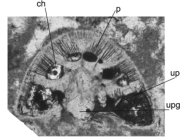Foraminifera taxon details
Rotorbinella campaniola Boix, Villalonga, Caus & Hottinger, 2009 †
1073663 (urn:lsid:marinespecies.org:taxname:1073663)
accepted
Species
marine, brackish, fresh, terrestrial
fossil only
Boix, C.; Villalonga, R.; Caus, E.; Hottinger, L. (2009). Late Cretaceous rotaliids (Foraminiferida) from the Western Tethys. <em>Neues Jahrbuch für Geologie und Paläontologie - Abhandlungen.</em> 253(2): 197-227., available online at https://www.researchgate.net/publication/233570490_Late_Cretaceous_rotaliids_Foraminiferida_from_the_Western_Tethys [details] Available for editors  [request]
[request]
Hayward, B.W.; Le Coze, F.; Vachard, D.; Gross, O. (2024). World Foraminifera Database. Rotorbinella campaniola Boix, Villalonga, Caus & Hottinger, 2009 †. Accessed at: https://marinespecies.org/foraminifera/aphia.php?p=taxdetails&id=1073663 on 2024-04-24
Date
action
by
original description
Boix, C.; Villalonga, R.; Caus, E.; Hottinger, L. (2009). Late Cretaceous rotaliids (Foraminiferida) from the Western Tethys. <em>Neues Jahrbuch für Geologie und Paläontologie - Abhandlungen.</em> 253(2): 197-227., available online at https://www.researchgate.net/publication/233570490_Late_Cretaceous_rotaliids_Foraminiferida_from_the_Western_Tethys [details] Available for editors  [request]
[request]
From editor or global species database
Original description External characteristics. The shell shows a very convex dorsal side with particularly thick walls and a flat ventral side. The dorsal side is smooth, without any ornamentation, perforated by wide pores. The thick secondary lamellae that cover the rounded apex of the shell remind us of a mushroom cap. The chambers are arranged in a high trochospire. The edge of the last whorl is marked by an imperforate keel. The shape of the ventral side can vary from slightly convex to plane or even concave. The ventral chamber walls lack any ornament. The umbilical face is occupied by a single massive umbilical plug, surrounded by a deep, narrow umbilical interlocular space. The folia remain small. They are imperforate and slightly oblique with a backward inclination. The foliar suture is marked by a small sutural notch. The trochospire shows three spiral whorls with quadrangular chambers. The very small proloculus has a diameter that does not exeed 0.02 mm. The number of the chambers in the last whorl is about 6. The diameter varies from 0.64 to 0.8 mm and the height 0.41 to 0.61 mm. The ratio D/H is about 1.47. On the dorsal side, the septa of the approximately isometric chambers are slightly curved and inclined backwards. On the ventral side, the chambers are twice as long as on the dorsal side. This means, that the inclination of the septa increases in ventral direction in order to produce a sectorial overlap of successive spiral chambers in the last whorl for about half of the chamber’s length. [details]
